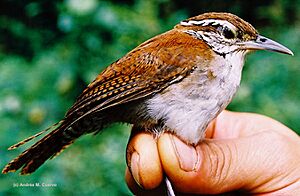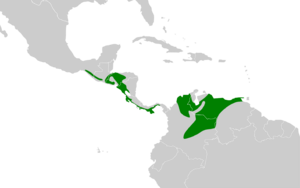Rufous-and-white wren facts for kids
Quick facts for kids Rufous-and-white wren |
|
|---|---|
 |
|
| Conservation status | |
| Scientific classification | |
| Genus: |
Thryophilus
|
| Species: |
rufalbus
|
 |
|
| Synonyms | |
|
Thryothorus rufalbus |
|
The rufous-and-white wren (Thryophilus rufalbus) is a small songbird that belongs to the wren family. These birds live in areas from southwestern Mexico all the way to northern Colombia and northwestern Venezuela. They stay in these regions year-round.
Contents
What Does the Rufous-and-White Wren Look Like?
This wren is about 14 to 15 centimeters (about 5.5 to 6 inches) long. It weighs between 22 and 25 grams (less than an ounce). Its back is a rich chestnut brown, with a slightly darker head.
You can spot a clear white stripe above its eye, called a supercilium. It also has a brown stripe going through its eye and black streaks on its cheeks. The underside of its body is white. Its lower belly has black stripes, and its sides are brown. Both its wings and tail have black stripes.
Young rufous-and-white wrens are not as brightly colored. Their upper parts are duller, and their undersides have a buff (yellowish-tan) tint. There is a special type of this wren, T. r. minlosi, found in Venezuela. This one has a grayish color on its head and underside.
Where Do These Wrens Live?
The rufous-and-white wren lives in lowlands and foothills. You can find them from sea level up to about 1,500 meters (almost 5,000 feet) high. They prefer dry forests. In wetter areas, they live in more open, scrubby woodlands. In Central America, they are mostly found on the Pacific side of the main mountain ranges.
Sounds and Calls
This wren has a very unique voice! Its call is a sharp chek or a quick tuck. The song is a beautiful and clear series of slow, hooting whistles. It sounds like weee, boo, boo, booo, boo, whit.
Sometimes, a pair of wrens will sing together. One bird will sing the main song, and the other will respond with a soft, purring sound like ou-ou-ou-oouu,u,u,u.
What Do They Eat?
The rufous-and-white wren looks for food in pairs. They actively search in low plants or on the ground. They are quite shy, so you might hear them more often than you see them. Their diet mainly consists of insects, spiders, and other small creatures without backbones, called invertebrates.
Reproduction and Life Cycle
These wrens build their nests in the shape of a flask. They place these nests about 2 to 3 meters (about 6.5 to 10 feet) high in a tree or a bush.
The female wren is the one who sits on the eggs. She lays three or four greenish-blue eggs. She keeps them warm for about two weeks until they hatch. After hatching, the young birds are ready to leave the nest in about the same amount of time.


